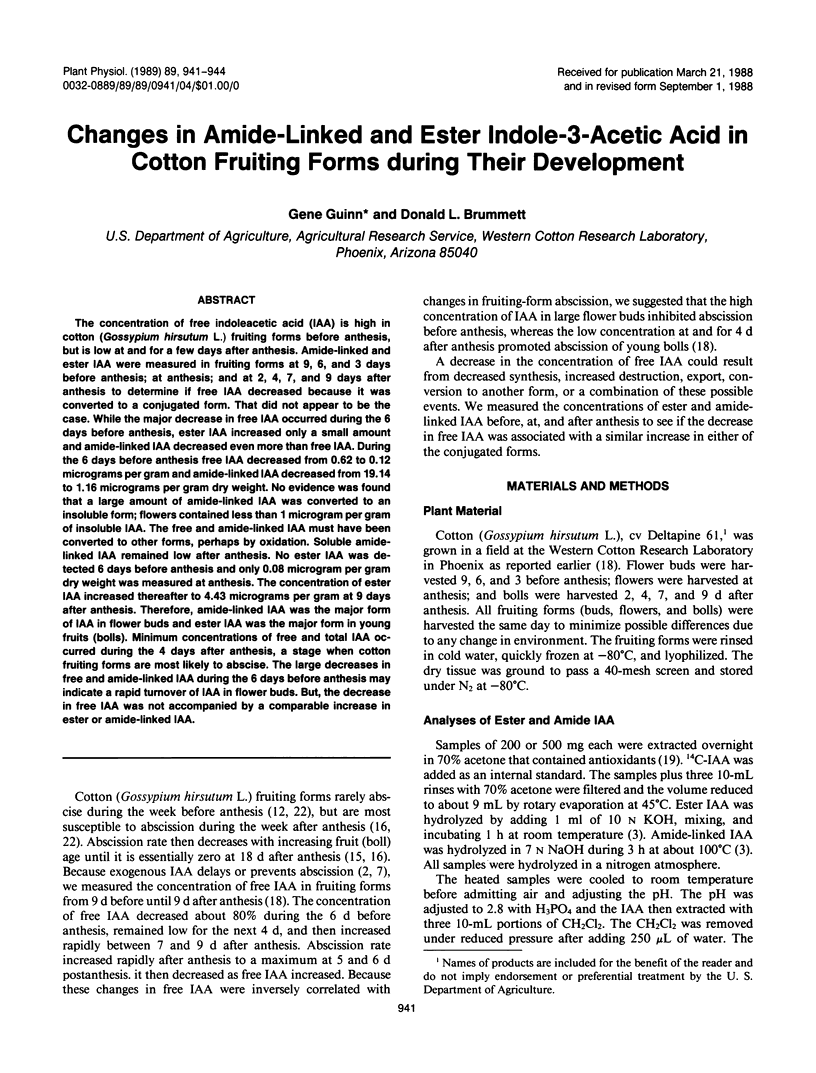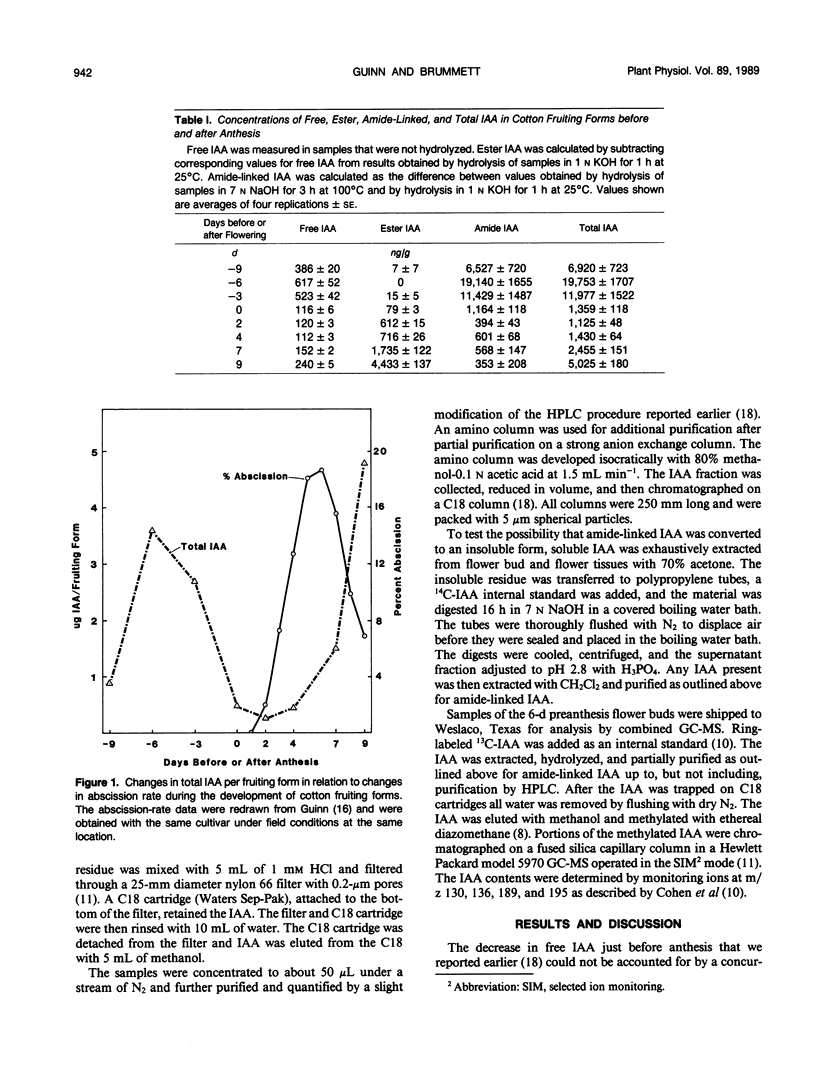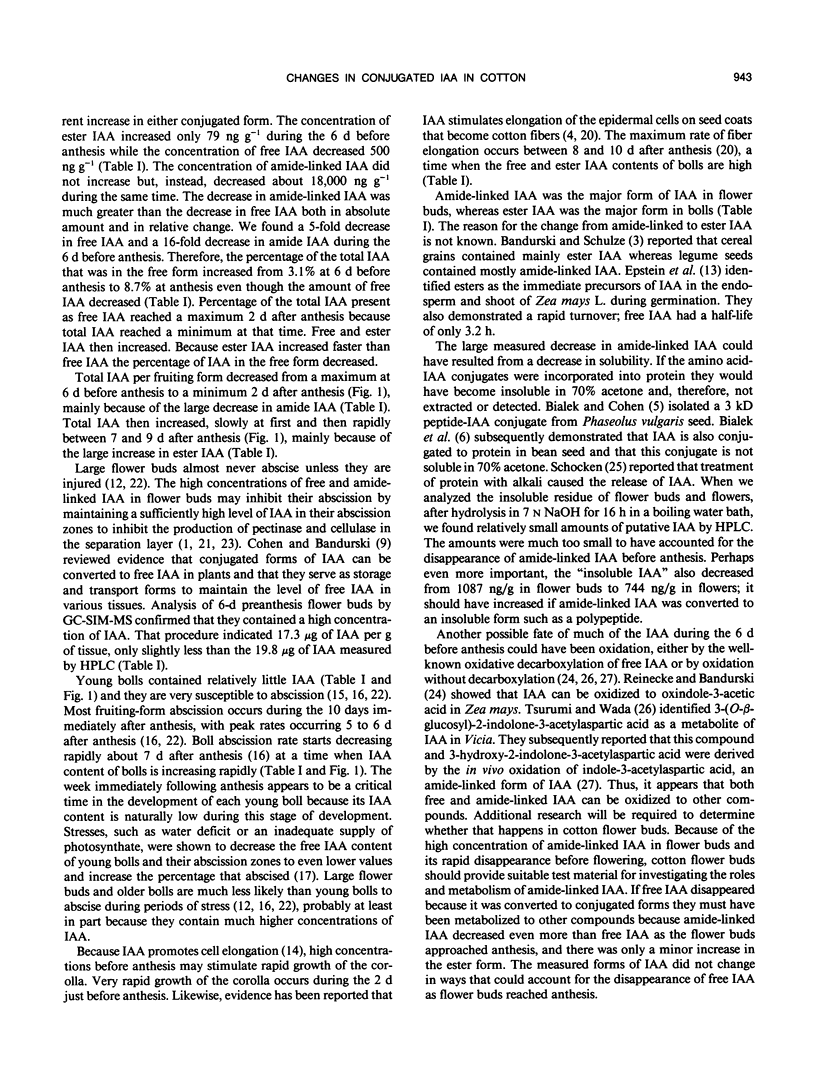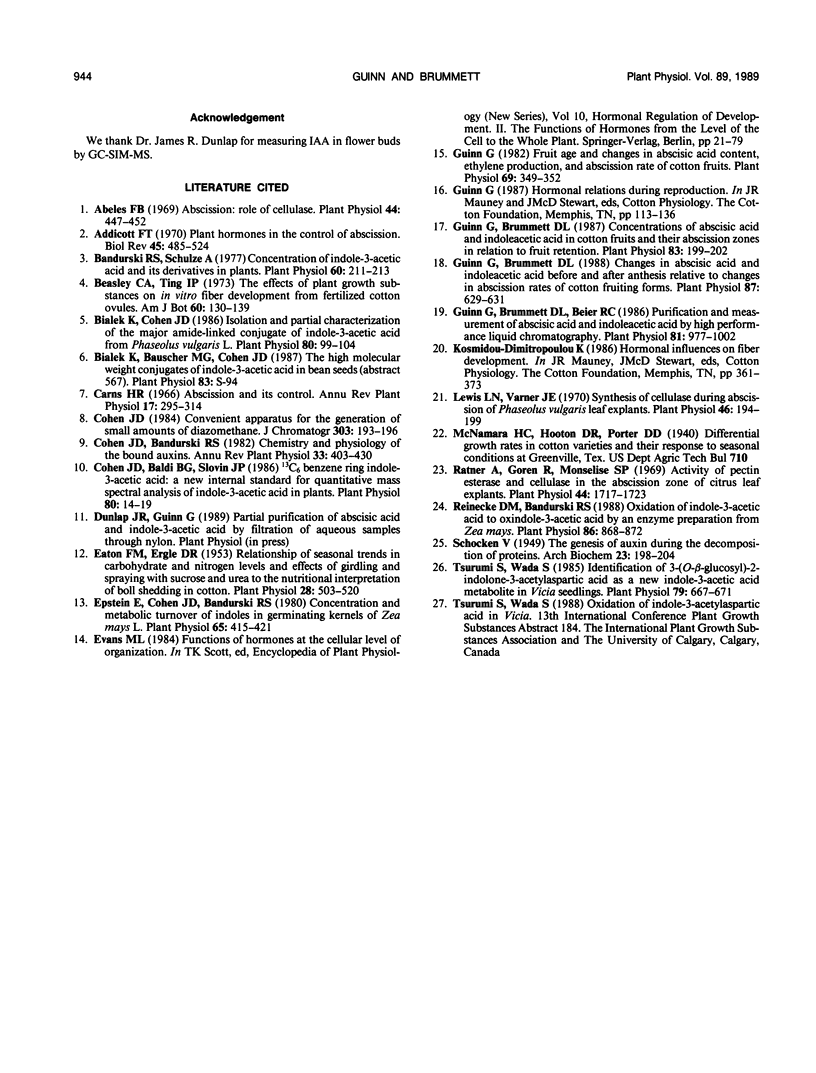Abstract
The concentration of free indoleacetic acid (IAA) is high in cotton (Gossypium hirsutum L.) fruiting forms before anthesis, but is low at and for a few days after anthesis. Amide-linked and ester IAA were measured in fruiting forms at 9, 6, and 3 days before anthesis; at anthesis; and at 2, 4, 7, and 9 days after anthesis to determine if free IAA decreased because it was converted to a conjugated form. That did not appear to be the case. While the major decrease in free IAA occurred during the 6 days before anthesis, ester IAA increased only a small amount and amide-linked IAA decreased even more than free IAA. During the 6 days before anthesis free IAA decreased from 0.62 to 0.12 micrograms per gram and amide-linked IAA decreased from 19.14 to 1.16 micrograms per gram dry weight. No evidence was found that a large amount of amide-linked IAA was converted to an insoluble form; flowers contained less than 1 microgram per gram of insoluble IAA. The free and amide-linked IAA must have been converted to other forms, perhaps by oxidation. Soluble amide-linked IAA remained low after anthesis. No ester IAA was detected 6 days before anthesis and only 0.08 microgram per gram dry weight was measured at anthesis. The concentration of ester IAA increased thereafter to 4.43 micrograms per gram at 9 days after anthesis. Therefore, amide-linked IAA was the major form of IAA in flower buds and ester IAA was the major form in young fruits (bolls). Minimum concentrations of free and total IAA occurred during the 4 days after anthesis, a stage when cotton fruiting forms are most likely to abscise. The large decreases in free and amide-linked IAA during the 6 days before anthesis may indicate a rapid turnover of IAA in flower buds. But, the decrease in free IAA was not accompanied by a comparable increase in ester or amide-linked IAA.
Full text
PDF



Selected References
These references are in PubMed. This may not be the complete list of references from this article.
- Abeles F. B. Abscission: role of cellulase. Plant Physiol. 1969 Mar;44(3):447–452. doi: 10.1104/pp.44.3.447. [DOI] [PMC free article] [PubMed] [Google Scholar]
- Bandurski R. S., Schulze A. Concentration of Indole-3-acetic Acid and Its Derivatives in Plants. Plant Physiol. 1977 Aug;60(2):211–213. doi: 10.1104/pp.60.2.211. [DOI] [PMC free article] [PubMed] [Google Scholar]
- Bialek K., Cohen J. D. Isolation and Partial Characterization of the Major Amide-Linked Conjugate of Indole-3-Acetic Acid from Phaseolus vulgaris L. Plant Physiol. 1986 Jan;80(1):99–104. doi: 10.1104/pp.80.1.99. [DOI] [PMC free article] [PubMed] [Google Scholar]
- Cohen J. D., Baldi B. G., Slovin J. P. C(6)-[benzene ring]-indole-3-acetic Acid: a new internal standard for quantitative mass spectral analysis of indole-3-acetic Acid in plants. Plant Physiol. 1986 Jan;80(1):14–19. doi: 10.1104/pp.80.1.14. [DOI] [PMC free article] [PubMed] [Google Scholar]
- Eaton F. M., Ergle D. R. Relationship of Seasonal Trends in Carbohydrate and Nitrogen Levels and Effects of Girdling and Spraying with Sucrose and Urea to the Nutritional Interpretation of Boll Shedding in Cotton. Plant Physiol. 1953 Jul;28(3):503–520. doi: 10.1104/pp.28.3.503. [DOI] [PMC free article] [PubMed] [Google Scholar]
- Epstein E., Cohen J. D., Bandurski R. S. Concentration and Metabolic Turnover of Indoles in Germinating Kernels of Zea mays L. Plant Physiol. 1980 Mar;65(3):415–421. doi: 10.1104/pp.65.3.415. [DOI] [PMC free article] [PubMed] [Google Scholar]
- Guinn G., Brummett D. L., Beier R. C. Purification and measurement of abscisic Acid and indoleacetic Acid by high performance liquid chromatography. Plant Physiol. 1986 Aug;81(4):997–1002. doi: 10.1104/pp.81.4.997. [DOI] [PMC free article] [PubMed] [Google Scholar]
- Guinn G., Brummett D. L. Changes in Abscisic Acid and Indoleacetic Acid before and after Anthesis Relative to Changes in Abscission Rates of Cotton Fruiting Forms. Plant Physiol. 1988 Jul;87(3):629–631. doi: 10.1104/pp.87.3.629. [DOI] [PMC free article] [PubMed] [Google Scholar]
- Guinn G., Brummett D. L. Concentrations of abscisic Acid and indoleacetic Acid in cotton fruits and their abscission zones in relation to fruit retention. Plant Physiol. 1987 Jan;83(1):199–202. doi: 10.1104/pp.83.1.199. [DOI] [PMC free article] [PubMed] [Google Scholar]
- Guinn G. Fruit age and changes in abscisic Acid content, ethylene production, and abscission rate of cotton fruits. Plant Physiol. 1982 Feb;69(2):349–352. doi: 10.1104/pp.69.2.349. [DOI] [PMC free article] [PubMed] [Google Scholar]
- Lewis L. N., Varner J. E. Synthesis of Cellulase during Abscission of Phaseolus vulgaris Leaf Explants. Plant Physiol. 1970 Aug;46(2):194–199. doi: 10.1104/pp.46.2.194. [DOI] [PMC free article] [PubMed] [Google Scholar]
- Ratner A., Goren R., Monselise S. P. Activity of pectin esterase and cellulase in the abscission zone of citrus leaf explants. Plant Physiol. 1969 Dec;44(12):1717–1723. doi: 10.1104/pp.44.12.1717. [DOI] [PMC free article] [PubMed] [Google Scholar]
- Reinecke D. M., Bandurski R. S. Oxidation of indole-3-acetic acid to oxindole-3-acetic acid by an enzyme preparation from Zea mays. Plant Physiol. 1988;86:868–872. doi: 10.1104/pp.86.3.868. [DOI] [PMC free article] [PubMed] [Google Scholar]
- Tsurumi S., Wada S. Identification of 3-(O-beta-Glucosyl)-2-Indolone-3-Acetylaspartic Acid as a New Indole-3-Acetic Acid Metabolite in Vicia Seedlings. Plant Physiol. 1985 Nov;79(3):667–671. doi: 10.1104/pp.79.3.667. [DOI] [PMC free article] [PubMed] [Google Scholar]


